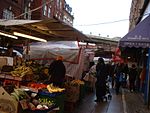Electric Avenue

Electric Avenue is a street in Brixton, London. Built in the 1880s, it was the first market street to be lit by electric lights (The first street to be lit by an incandescent lightbulb was Mosley Street, in Newcastle upon Tyne). Today, Electric Avenue contains various food and domestic provisions retailers, and hosts a part of Brixton Market which specialises in selling a mix of African, Caribbean, South American and Asian products. It is located just around the corner from Brixton Underground station (1972). The street originally had elegant cast iron Victorian canopies over the pavements which were removed and destroyed in the 1980s.
Excerpt from the Wikipedia article Electric Avenue (License: CC BY-SA 3.0, Authors, Images).Electric Avenue
Electric Avenue, London Stockwell (London Borough of Lambeth)
Geographical coordinates (GPS) Address Nearby Places Show on map
Geographical coordinates (GPS)
| Latitude | Longitude |
|---|---|
| N 51.46229 ° | E -0.11377 ° |
Address
Electric Avenue 30
SW9 8JR London, Stockwell (London Borough of Lambeth)
England, United Kingdom
Open on Google Maps










